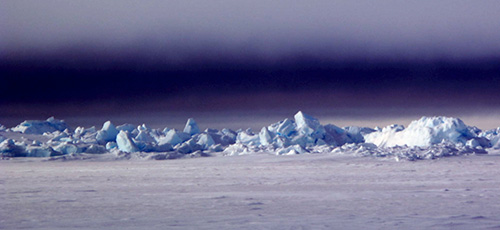 Alaska Science
Alaska Science
Life on ice at the top of the world
By NED ROZELL
February 28, 2015
Saturday AM
(SitNews) - On a February day long ago, a family living in a sod hut near the Arctic Ocean saw blocks of sea ice bulldozing their way onto shore. Winds shoved more ice until the mass towered above them and started dripping water through a ventilation hole. The father urged his family outside just before a slab fell on the hut and crushed him.
An ivu — the Inupiat word for mounds of ice that sometimes plow onto land, powered by winds and currents — is not often fatal, nor is it common these days. But stories of a few like this one from 1890 are now preserved on audio and some video in a recently completed project.

Sea ice north of Barrow.
Photograph by NED ROZELL
Over the years, researchers with the University of Alaska have traveled to Barrow for interviews and gathered existing recordings of the few Americans who live with sea ice.
The Natives interviewed talk of how sea ice used to form on the ocean in September and persist until June, while now they see open water in November or December. And how less ice survives summer's heat to form "multiyear" ice, which can better support the weight of a harvested whale.
"The stories reflect that the ice used to be thicker," said Karen Brewster of the UAF Oral History program, who compiled the interviews at www.jukebox.uaf.edu/seaice. "Pile-up events of thick chunks of ice were common. Now the ice just breaks up because it's too thin to pile up in the same way."
Brewster and others interviewed 26 residents of the North Slope from 1978 to 2013. Sea-ice scientist Lew Shapiro started talking with elders in the late 1970s when oil company executives became interested in the damage sea ice might inflict upon their structures. Shapiro's colleagues Ron Metzner and Kenneth Toovak interviewed more than a dozen people, including Otis Ahkivgak, who in 1979 told the story of the ivu that killed a man in 1890.
Twenty years after Shapiro's work, Matt Druckenmiller earned his PhD from UAF in part by interviewing Native hunters about their whaling trails and ice conditions. His request to Brewster to preserve the audio and photos inspired her to complete the project after adding a few of her own interviews.
The recordings are not edited, making the listener feel as if he or she is in a Barrow living room. Though this style makes the listener work for the gems within, they are there, like when Harry Brower talks about 1975, the year the ice never went out.
Scientists appreciate a long-term view. Sea-ice specialist Andy Mahoney, who learned much from Lew Shapiro and like Shapiro works at UAF’s Geophysical Institute, offered a current example as he flew over the ice of Camden Bay in late February 2015 by helicopter.
“As we approached the coast, we spotted a narrow lead at the shore, indicating the landfast ice was in the process of detaching from the coast,” he said via email from Deadhorse. “I was surprised to see this at this time of year and was tempted to think I was witnessing a rare and perhaps unique event.”
After pondering the open water all day, Mahoney pulled up satellite images after dinner and saw a similar event in a previous year.
“At a time when the Arctic is undergoing rapid change, it’s more important than ever to understand what is truly unprecedented and what is simply a repeat of earlier events,” he said. “This is why interviews with those who have a longer view of changes than the rest of us are particularly valuable.”
Since the late 1970s, the University of Alaska Fairbanks’ Geophysical Institute has provided this column in cooperation with the UAF research community.
Ned Rozell [nrozell@gi.alaska.edu] is a science writer for the Geophysical Institute.
Publish A Letter in SitNews
Contact the Editor
SitNews ©2015
Stories In The News
Ketchikan, Alaska
|
Articles &
photographs that appear in SitNews may be protected by copyright
and may not be reprinted without written permission from and
payment of any required fees to the proper sources.
E-mail your news &
photos to editor@sitnews.us
Photographers choosing to submit photographs for publication to SitNews are in doing so granting their permission for publication and for archiving. SitNews does not sell photographs. All requests for purchasing a photograph will be emailed to the photographer.
|
|

